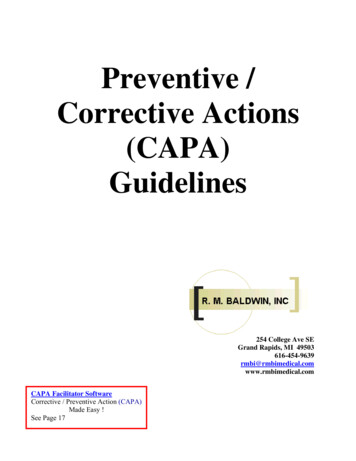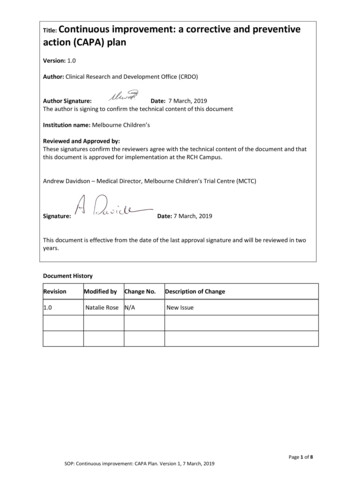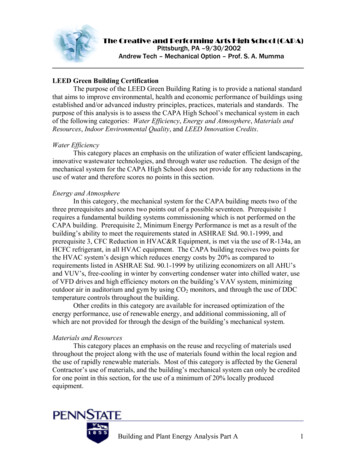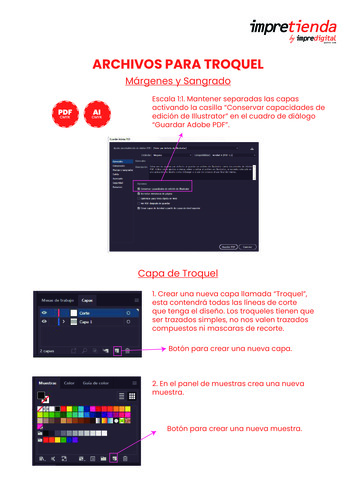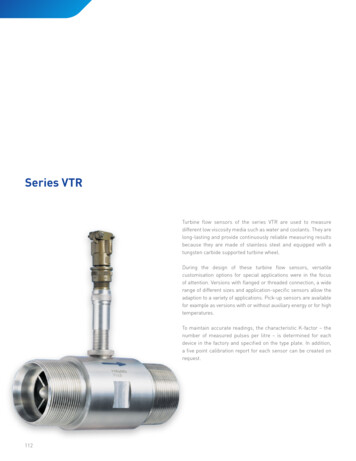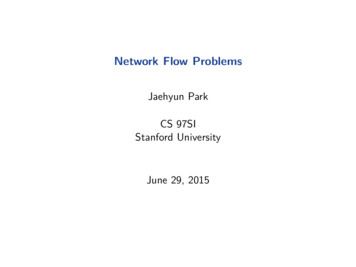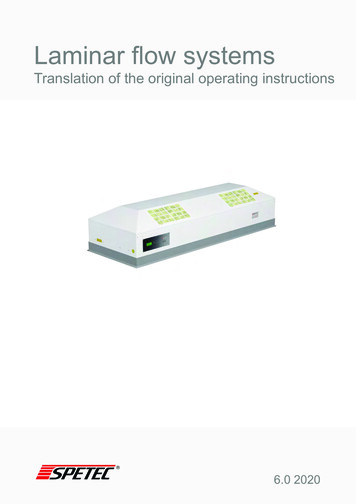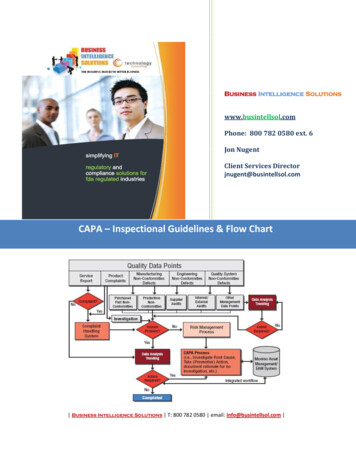
Transcription
Business Intelligence Solutionswww.busintellsol.comPhone: 800 782 0580 ext. 6Jon NugentClient Services Directorjnugent@busintellsol.comCAPA – Inspectional Guidelines & Flow Chart Business Intelligence Solutions T: 800 782 0580 email: info@busintellsol.com
Corrective Action Preventive Action, is an Important Part of a Quality Management SystemAn organization's corrective action preventive action (CAPA) process is central to all control points.Corrective actions are intended to determine the cause of non-conformances that have been detected, whilepreventive actions are the plan put in place to stop the problem from happening again in the future.Why is a Corrective Action Preventive Action (CAPA) System Important?The methods for dealing with corrective and preventive actions require a high level of accuracy and flexibility.Rigorous regulatory and traceability requirements exist in industries such as aerospace, automotive, defense,life sciences or any other manufacturing operation.Implementing a corrective preventive action (CAPA) system should be an important part of any corporatequality system, regardless of industry.Corrective Action Preventive Action (CAPA) SoftwareCorrective action preventive action (CAPA) systems can serve as the cornerstone of Six Sigma, Lean and othercost reduction and process improvement efforts. FDA-regulated industries are legally mandated to complywith 21 CFR Part 11 and meet FDA GMP, GLP and GCP requirements.Steps in a Corrective Action ProcedureA corrective action procedure is not reworking or remaking an item to bring it back into specification.Patching up a mistake doesn't address what made it happen in the first place and it won't prevent a recurrence.A corrective action procedure can be documented using either a paper or electronic system. Either way, theprocess is basically the same: Document that was specified versus one that was found. Check the functional specifications and any otherrequirements against the actual result.Determine how much time should be allowed for a corrective action procedure (or CAPA response).Decide who will investigate the problem, find a solution and perform the corrective action procedure.Research and document the cause of the problem.Plan how to keep the problem from recurring.Communicate the corrective action procedure to everyone involved, at each appropriate level.Periodically check to ensure the problem is solved and that the corrective action procedure was effective. Business Intelligence Solutions T: 800 782 0580 email: info@busintellsol.com
Corrective and Preventive Actions (CAPA)Inspectional Objectives1. Verify that CAPA system procedure(s) that address the requirements of the quality system regulation havebeen defined and documented.2. Determine if appropriate sources of product and quality problems have been identified. Confirm that datafrom these sources are analyzed to identify existing product and quality problems that may require correctiveaction.3. Determine if sources of product and quality information that may show unfavorable trends have beenidentified. Confirm that data from these sources are analyzed to identify potential product and qualityproblems that may require preventive action.4. Challenge the quality data information system. Verify that the data received by the CAPA system arecomplete, accurate and timely.5. Verify that appropriate statistical methods are employed (where necessary) to detect recurring qualityproblems. Determine if results of analyses are compared across different data sources to identify and developthe extent of product and quality problems. Business Intelligence Solutions T: 800 782 0580 email: info@busintellsol.com
6. Determine if failure investigation procedures are followed. Determine if the degree to which a qualityproblem or nonconforming product is investigated is commensurate with the significance and risk of thenonconformity. Determine if failure investigations are conducted to determine root cause (where possible).Verify that there is control for preventing distribution of nonconforming product.7. Determine if appropriate actions have been taken for significant product and quality problems identifiedfrom data sources.8. Determine if corrective and preventive actions were effective and verified or validated prior toimplementation. Confirm that corrective and preventive actions do not adversely affect the finished device.9. Verify that corrective and preventive actions for product and quality problems were implemented anddocumented.10. Determine if information regarding nonconforming product and quality problems and corrective andpreventive actions has been properly disseminated, including dissemination for management review. Business Intelligence Solutions T: 800 782 0580 email: info@busintellsol.com
Business Intelligence Solutions T: 800 782 0580 email: info@busintellsol.com
Corrective and Preventive Actions (CAPA)NarrativePurpose/ImportanceThe purpose of the corrective and preventive action subsystem is to collectinformation, analyze information, identify and investigate product and qualityproblems, and take appropriate and effective corrective and/or preventive action toprevent their recurrence. Verifying or validating corrective and preventive actions,communicating corrective and preventive action activities to responsible people,providing relevant information for management review and documenting theseactivities are essential in dealing effectively with product and quality problems,preventing their recurrence, and preventing or minimizing device failures.One of the most important quality system elements is the corrective and preventiveaction subsystem.1. Verify that CAPA system procedure(s) that address the requirements of the quality systemregulation have been defined and documented.Review the firm's corrective and preventive action procedure. If necessary, have management providedefinitions and interpretation of words or terms such as "nonconforming product", "quality audit","correction", "prevention", "timely", and others. It is important to gain a working knowledge of the firm'scorrective and preventive action procedure before beginning the evaluation of this subsystem.NOTE: Corrective action taken to address an existing product or qualityproblem should include action to: Correct the existing product nonconformity or quality problems and; Prevent the recurrence of the problemThe CAPA procedure should include procedures for how the firm will meet the requirements for all elementsof the CAPA subsystem. All procedures should have been implemented.Once you have gained a knowledge of the firm's corrective and preventive action procedure, begin withdetermining if the firm has a system for the identification and input of quality data into the CAPA subsystem.Such data includes information regarding product and quality problems (and potential problems) that mayrequire corrective and/or preventive action.2. Determine if appropriate sources of product and quality problems have been identified. Confirmthat data from these sources are analyzed to identify existing product and quality problems that mayrequire corrective action.
The firm should have methods and procedures to input product or quality problems into the CAPA subsystem.Product and quality problems should be analyzed to identify product and quality problems that may requirecorrective action.The firm should routinely analyze quality data regarding product and quality problems. This analysis shouldinclude data and information from all acceptance activities, complaints, service, and returned product records.Determine if the firm is capturing and analyzing data from acceptance activities relating to component, inprocess and finished device testing. Information obtained subsequent to distribution, which includescomplaints, service activities and returned products, as well as information relating to concessions (quality andnonconforming products), quality records, and other sources of quality data should also be captured andanalyzed. Examples of other sources of quality data include quality audits, installation reports, lawsuits, etc.NOTE: In accordance with Agency policy (CPG 7151.02), do not requestrecords regarding the results of internal quality audits, managementreviews, third party audits (including ISO audits), or supplier audits.However, you will be reviewing raw data that is used by the firm when conductingtheir quality audits, management reviews, etc. Trending information and results ofanalyses are generally part of evaluations under the corrective and preventiveaction requirements. This information is utilized in internal audits andmanagement reviews. Information or data utilized in internal audits andmanagement reviews are considered raw data and should be available for routinereview.3. Determine if sources of product and quality information that may show unfavorable trends havebeen identified. Confirm that data from these sources are analyzed to identify potential product andquality problems that may require preventive action.Determine if the firm is identifying product and quality problems that may require a preventive action. Thiscan be accomplished by reviewing historical records such as trending data, corrective actions, acceptanceactivities (component history records, process control records, finished device testing, etc.) and other qualitysystem records for unfavorable trends. Review if preventive actions have been taken regarding unfavorabletrends recognized from the analysis of product and quality information. Product and quality improvements anduse of appropriate statistical process control techniques are evidence of compliance with the preventive actionrequirement. Business Intelligence Solutions T: 800 782 0580 email: info@busintellsol.com
Determine if the firm is capturing and analyzing data regarding in-conformance product. Examples includecapturing and analyzing component test results to detect shifts in test results that may indicate changes invendor processes, component design or acceptance procedures. Identification of these indicators maynecessitate a vendor investigation as a preventive action. Monitoring in-process and finished device test resultsmay reveal additional indicators of potential quality problems. For devices where stability is an issue, testresults of reserve samples are continually monitored. These monitoring activities may trigger process changes,additional training activities and other changes required to maintain the process within its tolerances andlimits.Determine if the firm is using statistical control techniques for process controls where statistical techniques areapplicable. An example would be "Statistical Process Control" (SPC). SPC is utilized to monitor a process andinitiate process correction when a process is drifting toward a specification limit. Typically, SPC activities areencountered with large volume production processes such as plastic molding and extrusion. Any continuingproduct improvements (in the absence of identified product problems such as non-conforming product) arealso positive indicators of preventive actions.Important linkages for this activity include 820.70 Production and Process Controls and 820.250Statistical Techniques.4. Challenge the quality data information system. Verify that the data received by the CAPA systemare complete, accurate and timely.Select one or two quality data sources. Using the sampling tables, review records from the chosen data sourcesto determine if the data were entered into the CAPA system. In addition, determine whether the data arecomplete, accurate and entered into the CAPA system in a timely manner.Important linkages for this activity include 820.80 Acceptance Activities, 820.90 NonconformingProduct, 820.170 Installation, 820.198 Complaint Files and 820.200 Servicing. Business Intelligence Solutions T: 800 782 0580 email: info@busintellsol.com
5. Verify that appropriate statistical methods are employed (where necessary) to detect recurringquality problems. Determine if results of analyses are compared across different data sources toidentify and develop the extent of product and quality problems.The analysis of product and quality problems should include appropriate statistical and non-statisticaltechniques. Statistical techniques include Pareto analysis, spreadsheets, and pie charts. Non-statisticaltechniques include quality review boards, quality review committees and other methods.The analysis of product and quality problems should also include the comparison of problems and trendsacross different data sources to establish a global, and not an isolated view, of a problem. For example,problems noted in service records should be compared with similar problem trends noted in complaints andacceptance activity information.The full extent of a problem must be captured before the probability of occurrence, risk analysis and the propercourse of corrective or preventive action can be determined.6. Determine if failure investigation procedures are followed. Determine if the degree to which aquality problem or nonconforming product is investigated is commensurate with the significance andrisk of the nonconformity. Determine if failure investigations are conducted to determine root cause(where possible). Verify that there is control for preventing distribution of nonconforming product.Review the firm's CAPA procedures for conducting failure investigations. Determine if the procedures includeprovisions for identifying the failure modes, determining the significance of the failure modes (using toolssuch as risk analysis), the rationale for determining if a failure analysis should be conducted as part of theinvestigation, and the depth of the failure analysis.Discuss with the firm their rationale for determining if a corrective or preventive action is necessary for anidentified trend regarding product or quality problems. The decision process may be linked to the results of arisk analysis and essential device outputs.Using the sampling tables, select failure investigation records regarding more than one failure mode (ifpossible) and determine if the firm is following their failure investigation procedures.Confirm that all of the failure modes from your selected sample of failure investigations have been capturedwithin data summaries such as reports, pie charts, spreadsheets, Pareto charts, etc.Determine whether the depth of the investigation (where possible) is sufficient (root cause) to determine thecorrective action necessary to correct the problem. Select one significant failure investigation that resulted in acorrective action and determine if the root cause had been identified so that verification or validation of thecorrective action could be accomplished.Using the sampling tables, review a number of incomplete failure investigations for potential unresolvedproduct non-conformances and potential distribution of nonconforming product. Unresolved problems thatcould be of significant risk to the patient or user may require product recall if the problem cannot be resolved. Business Intelligence Solutions T: 800 782 0580 email: info@busintellsol.com
Using the sampling tables, review records regarding nonconforming product where the firm concludedcorrective or preventive action was not necessary. As noted above, verify that the firm is not continuing todistribute nonconforming product. This may be an important deficiency based on the class of, and the riskassociated with, the product. Business Intelligence Solutions T: 800 782 0580 email: info@busintellsol.comImportant linkages for these activities include 820.20 ManagementResponsibility, 820.25 Training, 820.30 Design Controls, 820.90Nonconforming Product and possibly 820.250 Statistical Techniques.Using the sampling tables, review nonconforming product and qualityconcessions. Review controls for preventing distribution ofnonconforming products. Product and quality concessions should bereviewed to verify that the concessions have been made appropriate toproduct risk, within the requirements of the quality system and not solelyto fulfill marketing needs.Important linkages regarding these activities include 820.20Management Responsibility and 820.90 Nonconforming Product.7. Determine if appropriate actions have been taken for significant product and quality problemsidentified from data sources.Where appropriate, this may include recall actions, changes in acceptance activities for components, in-processand finished devices, etc.Using the sampling tables, select and review significant corrective actions and determine if the change orchanges could have extended beyond the action taken. A significant action would be a product or processchange to correct a reliability problem or to bring the product into conformance with product specifications.Discuss with the firm their rationale for not extending the action to include additional actions such as changesin component supplier, training, changes to acceptance activities, field action or other applicable actions.Investigators should discuss and evaluate these issues but be careful not to say anything that could beconstrued as requesting a product recall.8. Determine if corrective and preventive actions were effective and verified or validated prior toimplementation. Confirm that corrective and preventive actions do not adversely affect the finisheddevice.Using the selected sample of significant corrective and preventive actions, determine the effectiveness of thesecorrective or preventive actions. This can be accomplished by reviewing product and quality problem trendresults. Determine if there are any similar product or quality problems after the implementation of thecorrective or preventive actions. Determine if the firm has verified or validated the corrective or preventiveactions to ensure that such actions are effective and do not adversely affect the finished device.
Corrective actions must be verified and (if applicable) validated. Corrective actions must include theapplication of design controls if appropriate.Good engineering principles should include: establishing a verification or validation protocol; verification ofproduct output against documented product requirements and specifications; ensuring test instruments aremaintained and calibrated; and that test results are maintained, available and readable.Important linkages regarding this CAPA element include 820.30 Design Control and 820.70(b)Production and Process Control.9. Verify that corrective and preventive actions for product and quality problems were implementedand documented.Using the sampling tables, select and review records of the most recent corrective or preventive actions (thissample may consist of or include records from the previously selected sample of significant correctiveactions). To determine if corrective and preventive actions for product and quality problems and changes havebeen documented and implemented it may be necessary to view actual processes, equipment, facilities ordocumentation.10. Determine if information regarding nonconforming product and quality problems and correctiveand preventive actions has been properly disseminated, including dissemination for managementreview.Determine that the relevant information regarding quality problems, as well as corrective and preventiveactions, has been submitted for management review. This can be accomplished by determining which recordsin a recent CAPA event were submitted for management review. Review the raw data submitted formanagement review and not the actual results of a management review.Review the CAPA (and other procedures if necessary) and confirm that there is a mechanism to disseminaterelevant CAPA information to those individuals directly responsible for assuring product quality and theprevention of quality problems.Review information related to product and quality problems that have been disseminated to those individualsdirectly responsible for assuring product quality and the prevention of quality problems. Using the sample ofrecords from Objective 9 above, confirm that information related to product and quality problems isdisseminated to individuals directly responsible for assuring product quality and the prevention of qualityproblems. Business Intelligence Solutions T: 800 782 0580 email: info@busintellsol.com
Business Intelligence Solutions offers very practical steps on how to implement some of the sweepingregulatory changes in the mindsets of executives working in FDA regulated industries, in bite-sized steps.Our client approach allows you to immediately access the technology resources and talent youneed to run your project, without having to create a stand-alone unit. Our capabilities add leverage to yourtechnology investments and reduce cost to create sustainability in a climate of reduced resources.“To Subscribe To Our Blog”Information Technology Resources that Match Your Business NeedsMany companies lack the resources to cover all competencies along the application lifecycle. With on-demandaccess to skilled specialists, you can leave your application management queries to us and focus on your corecompetencies.Our Application Skills on Demand is a single professional services contract that provides access to our projectmanagers, business analysts, application technicians and other application management specialistsExpand Into New Markets - Improve Productivity - Lower Operating CostsBusiness Intelligence Solutions provides innovative quality system and regulatory compliance solutions thatlowers operating cost, improves company performance and accelerates innovation.Download our Capabilities Brochure here.As a trusted business partner to over 100 FDA regulated companies and healthcare organizations, we haveconducted more than 500 successful engagements through our partners’ professional services organizationsand offerings.Looking to be kept informed, then head over to our Learning Center, where you can conduct research, identifyoptions and review solutions related to Quality Systems and Compliance as well as other industry issues. Business Intelligence Solutions T: 800 782 0580 email: info@busintellsol.com
Quality Systems & Compliance ConsultingBusiness Intelligence Solutions provides innovative quality system and regulatory compliance solutions thatimprove performance, eliminate inefficiencies, and increase compliance.Customized, Practical SolutionsQuality and compliance do not come sold in a box. Companies need real world guidance, not textbookanswers. Advice must be practical for the specific situation. MBC & Associates provides real world answersthat come from our breadth and depth of experience.Our extensive list of Quality System and Regulatory Compliance services provides just the start for designinga custom solution for your business needs.Our Services Quality Assessments & AuditingQuality System Design & ImplementationSoftware Configuration, Validation & ImplementationProject ManagementRegulatory Affairs and TrainingQuality Assessments & AuditingWe provide complete assessment and audit reports including detailed recommendations for systemimprovement, ways to reduce regulatory risk, and increase business efficiency based on industry best practices.Some of the services we offer are: Quality System & compliance assessments Development and management of Internal Quality Audit programs Development and management of Supplier Quality Audit programs FDA QSIT, ISO 13485, ISO 14971, and ISO 9001 assessments & audit preparation MDD, IVDD, CMDR, and FDA Part 11 assessments & audit preparation Mock FDA Inspections Business Intelligence Solutions T: 800 782 0580 email: info@busintellsol.com
Quality System Design & ImplementationWe offer comprehensive quality system and regulatory compliance leadership for the creation or re-design ofquality systems. We work closely with your team to develop and author individualized quality system policiesand procedures to enhance your compliance efforts and support your specific business needs.Some of the services we offer are: Quality System design & deployment Quality System gap analysis & re-engineering Document and Change Control business systems Data & Records Management business systems Design Control strategies & process development Development and implementation of CAPA programs Development and implementation of Complaint Handling systems Nonconforming Material programs & management Process Validation programs & assistance FDA Facility Registration assistance Recall & Field Correction assistanceProject ManagementEffective project management is critical to the success of any quality system implementation or re-engineeringeffort. We offer comprehensive project management services for the complete life-cycle of theimplementation or re-engineering effort, including PM support for any software application configuration,validation, and implementation efforts. We work closely with your implementation team to ensure the projectis completed with the highest quality, on time, and within budget.Project management professional services include: The Project Manager assigned to the project will work closely with the client’s implementation team todefine and document major tasks, milestones, deliverables, timelines, and resources needed tosuccessfully complete the project. S/he will act as liaison between implementation personnel, management, and vendors by conductingmeetings to review project details and obtain necessary reviews and approvals. Business Intelligence Solutions T: 800 782 0580 email: info@busintellsol.com
S/he will monitor all phases of the project, review status reports, and modify schedules or plans asrequired. The Project Manager will also prepare regular project reports for the client and other definedstakeholders. The Project Manager will confer with project personnel to provide technical advice to resolve issues.Regulatory Affairs ConsultingBusiness Intelligence Solutions provides comprehensive assistance to FDA regulated companies attempting toget their medical device or pharmaceutical product through the regulatory process.No matter what phase you're in, we can provide direction and hands-on support to help you: Develop a regulatory road map. A clear path through the regulatory hurdles that will face yourbusiness including documentation and testing requirements and risk and obstacle assessments. Ourexperience with low and high risk devices has given us the ability to anticipate exactly what the FDAwill be looking for. Identify Design Control deliverables. We will assist with ensuring that all Design Controldeliverables required by the FDA are completed before you file with the FDA. Write and deliver your submission to the FDA. Secure FDA approval for the first time. We will defend your submission during the review processwith the FDA and assist with securing approval for your device or IVD. Audit and manage critical contract suppliers. Establish your first Quality System. We create procedures; provide training, support andstabilization.Regulatory Affairs ServicesWe provide full-service regulatory affairs assistance to support your product development pipeline andemerging technologies including: Strategic planning Clinical study protocols & IRB approvals Bio-Informatics and statistical analysis 510(k) and PMA submissions Project Management Regulatory Assessments Regulatory strategies & submissions Design Control Process assistance Business Intelligence Solutions T: 800 782 0580 email: info@busintellsol.com
Regulatory TrainingWe will assist you in developing an efficient and compliant training system that works for your business.Additionally, we can create customized training courses designed specifically for audiences ranging from theexecutive board room to manufacturing operators/technicians to field service personnel.Some of the customized training services include: Instructional design Content development Expert delivery in a variety of class formats Testing and/or evaluation of effectiveness Certificates of completion or training records, as appropriate Business Intelligence Solutions T: 800 782 0580 email: info@busintellsol.com
CAPA - Inspectional Guidelines & Flow Chart. Corrective Action Preventive Action, is an Important Part of a Quality Management System An organization's corrective action preventive action (CAPA) process is central to all control points. . Monitoring in-process and finished device test results may reveal additional indicators of potential .
